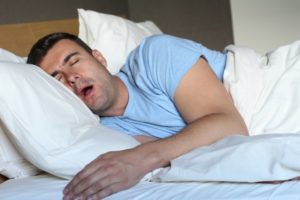Learning About Obstructive Sleep Apnea in The Woodlands
May 17, 2019
 When you’re listening to someone snore, pay attention to their breathing; if they stop and start, it could be a sign of something much more serious than a nighttime annoyance. Roughly 50 to 70 million American adults have some kind of sleep disorder, and there’s one in particular that affects over 100 million people worldwide. Here’s what you need to know about identifying and treating obstructive sleep apnea in The Woodlands.
When you’re listening to someone snore, pay attention to their breathing; if they stop and start, it could be a sign of something much more serious than a nighttime annoyance. Roughly 50 to 70 million American adults have some kind of sleep disorder, and there’s one in particular that affects over 100 million people worldwide. Here’s what you need to know about identifying and treating obstructive sleep apnea in The Woodlands.
What is Obstructive Sleep Apnea?
Sleep apnea is when a person’s breathing repeatedly stops and starts while they’re asleep. The most prevalent kind is obstructive sleep apnea that occurs when the airway is physically closed; this is often due to the collapse of the soft tissue in the back of the throat. It’s more common in men and is often associated with obesity.
What are the Symptoms of Sleep Apnea?
Sleep apnea symptoms often include extremely loud snoring; chances are that people who sleep nearby will notice this before you do. Other signs to watch out for include:
- Being persistently sleepy during the daytime
- Occasionally waking up gasping for air during the night
- Often waking up with a dry mouth or headache
Note that not all these symptoms will necessarily be present. The only certain way to diagnose sleep apnea is through a sleep study that can be performed in a laboratory or at home. If the condition is not treated, it can lead to high blood pressure, cardiovascular diseases, memory problems and weight gain.
How Can Sleep Apnea Be Treated?
There are a few sleep apnea treatment options to consider, with one of the most commonly prescribed being CPAP therapy. CPAP stands for “continuous positive airway pressure”; a facemask connected to an air pump is used to provide a steady stream of oxygen. This is very effective in ensuring air flow, but it can be noisy and is somewhat inconvenient while traveling.
Oral appliance therapy is a popular alternative to CPAP therapy. A simple custom-made mouthguard slightly shifts the jaw forward, which prevents the soft tissues in the mouth in throat from collapsing. Many patients favor it over other methods, although it may not be effective in severe cases. Note that in some cases, CPAP and oral appliance therapy are used at the same time; the mouthguard allows the machine to be placed at a lower, less noisy setting. It also lets you use a smaller facemask.
If you suspect obstructive sleep apnea, it’s best to get treatment as soon as possible to avoid long-term negative effects. Make an appointment with a dentist who has training in treating the condition; they’ll perform the necessary tests and try to identify the root cause. The sooner you receive therapy, the easier it will be to get a good night’s rest!
About the Author
Dr. Robert G. Dernick opened his first practice in The Woodlands in 1980; after initially practicing general and cosmetic dentistry, he started researching sleep dentistry and treatments for sleep apnea. He offers CPAP and oral appliance therapy for patients in order to improve the quality of their sleep. To schedule an appointment, visit his website or call (281) 363-2770.
No Comments
No comments yet.
RSS feed for comments on this post.
Sorry, the comment form is closed at this time.
 Sleep Apnea &
Sleep Apnea &